Last Updated on October 17, 2023
In this blog article Slávka shares her experience of a study trip to Austria and Germany organized by iEPD, which was focused on sustainable architecture projects and famous sustainable architects. She describes her personal observations and excursion impressions, and concludes with her viewpoint of informal education and how build_shift as an organization aims to support networking beyond central Europe.
This morning I successfully woke up at 7.30, which I had been trying to push myself to do for the last 26 days. Full of energy and feeling like an adult, finally, I was ready to be productive, whatever that means. And I received an email. Slávka, call me ASAP. Oh, I know what is happening. Me, my still half-asleep body and the voice of a 70 year old smoker come together to call the number I was sent via the email message.
“Slávka, we are boarding the bus right now and one person is missing. If you wanna join the trip, get to Vienna ASAP.”
What happened next is me taking approximately 23 seconds to pack my backpack. I have been living out of a suitcase anyway, and I have packed for trips just in my backpack already way too many times (should I write this skill in my CV?). While nervously standing in the middle of my room, around a thousand thoughts flew through my head. I actually have plans for the weekend and this is generally not a good idea. That’s why I love it.
An hour later, I am sitting in a Blablacar with a Polish guy, talking about his car accident and German construction jobs. He takes me to Vienna suspiciously fast and there I join a group I’ve never seen before. Except dear Ivka, who I had a call with just a few hours ago. Now, let me explain what is actually going on here.
When I studied architecture, our faculty cooperated with one of the major Slovak sustainable built environment organizations, iEPD (Passive House Institute Slovakia). At the end of the semester, they organized an essay competition. The aim was to discuss the cities of the future and how they help to mitigate the effects of global warming. My essay (which I took like 20 minutes to write and all it needed was me getting pissed about educational approaches to architecture sustainability) was so amazingly amazing that it actually won. The prize was to attend a study tour that iEPD organized, which was supposed to happen that year, in Austria. The main goal was to discover innovative approaches to sustainability, see some passive buildings and learn from modern examples. Guess who got covid for the first time, after 2 years of lockdown, right before the excursion.
After I joined build_shift, I was trying to dig deeper into the community of organizations focusing on built environment sustainability in central/eastern europe. That is why I came back to iEPD and saw that the excursion is happening again. This year’s excursion was focused on the values of New European Bauhaus (beautiful | sustainable | together), and learning from inspiring examples of building renovation with sustainability and technology in mind. I pushed myself to not overthink and bravely sent an email. I mean, I do deserve to join if I won it already, right? Right? Sadly, the funding couldn’t cover expenses for an additional person like last time, but “we will call you in case someone doesn’t show up”. Yes…sure.
Well, and here I am.
I awkwardly stand next to a group of people which just destroyed 50 kilos of smoked pork knuckles, being grateful for the cold baguette which I managed to buy on my way here. I hang on Ivka with dear life, since missing the first lunch made me feel totally out of place. I ask, who are all the people joining us for the trip, because last time I met the head of Slovak architects chamber, I didn’t recognize him and I did most probably embarrass myself. She tells me some names which I try to remember like crazy to google later, but my short term memory fails and I only manage to remember that there is another student that won this trip and I feel relieved to not feel as an impostor in a group of middle-aged people anymore. We board the bus and next is a 6-hour journey to Dresden.
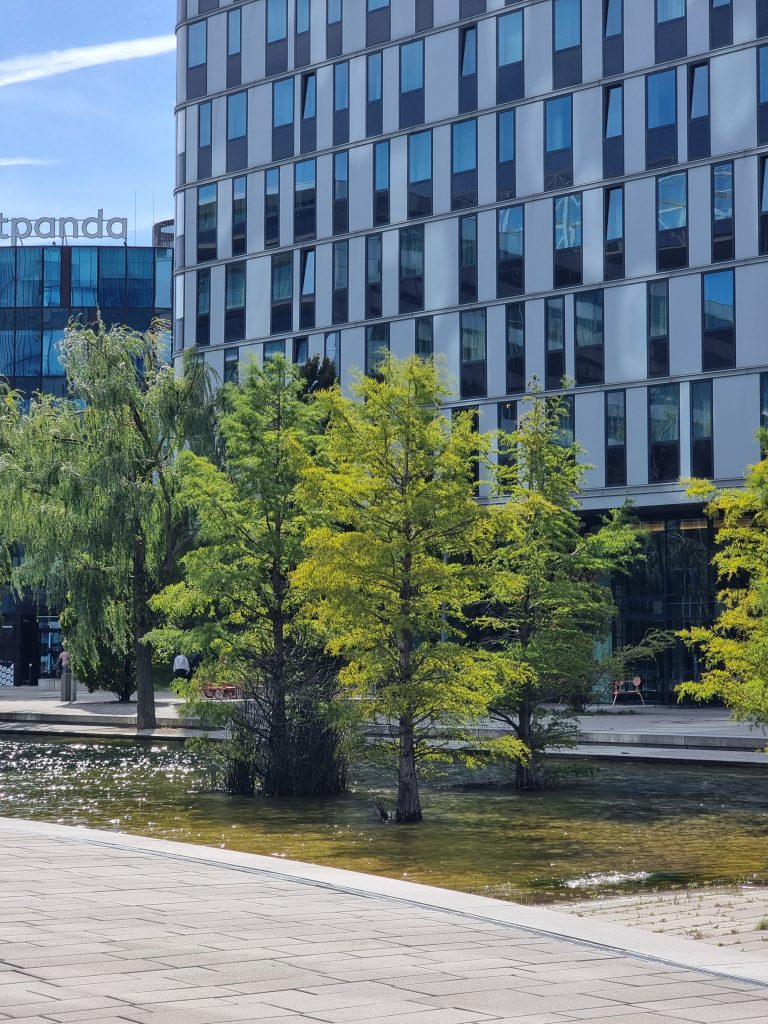
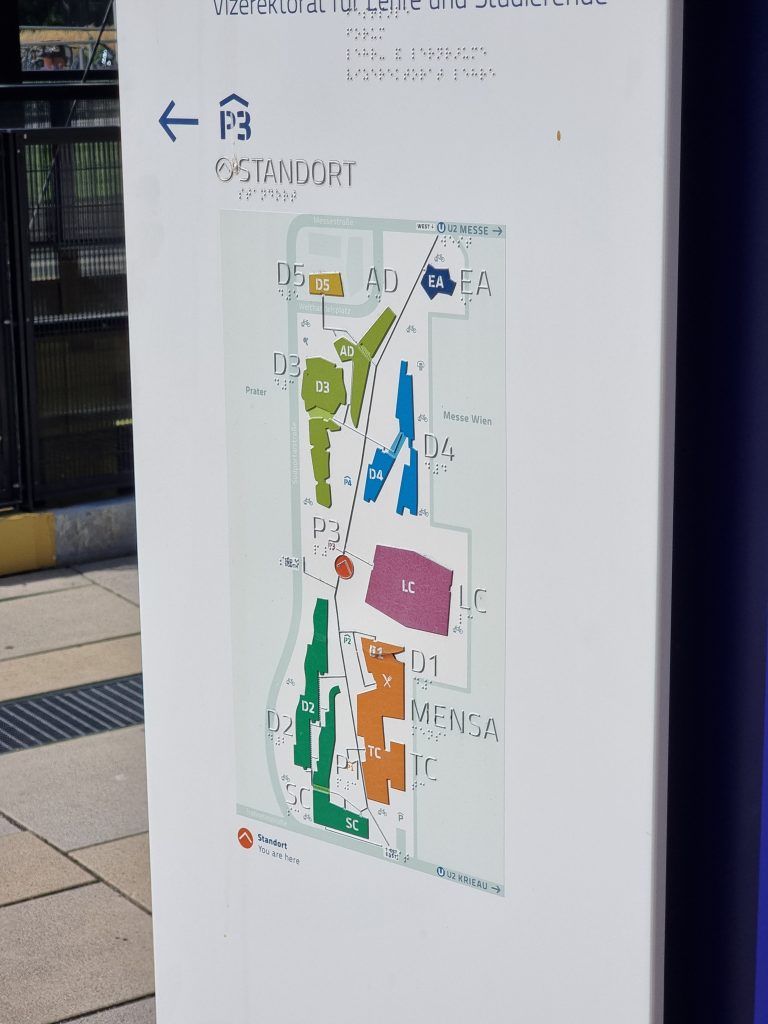
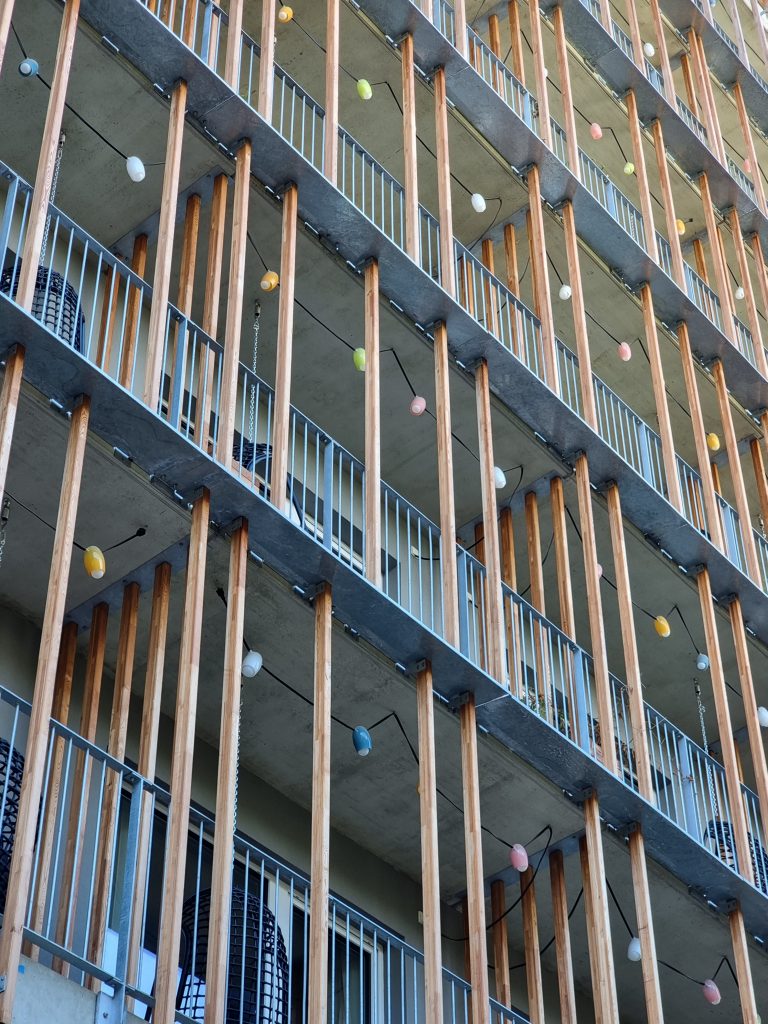
Don’t get me wrong, I absolutely love traveling and I weirdly enjoy long bus rides, but the whole process being so fast didn’t prepare me for the fact, that this bus is in fact not a fancy flixbus and my several-year-old Samsung battery will have to be a sufficient source of entertainment for the day. Dresden, here we come.
Arriving in Dresden quite late didn’t allow us to see the city while it was still sunlit. I sweat like crazy after walking 5 floors up the stairs of the hotel, but finally check into my fancy single room and am able to relax a bit. Yes, I did already accept the fact that I will be sharing a room with a 60 year old banker man whose friend didn’t show up, allowing me to join this trip, so staying alone adds to my already high spirits a tad bit more.
The thing is, I really just love discovering German cities. Maybe it’s my under-developed-country-mindset that is just not processing the fact that there are big functioning cities in this world, and public space can actually work in favor of people, but I was beaming with excitement to add some new cities to my German trip checklist. Awkwardly escaping the small group gathering outside of the hotel, which was planning to spend another two hours sitting at a restaurant, I jump the first Rewe I see, and dragging along several beer bottles in my tote, I pop open the first one on the nearest bicycle stand, light up my vacation cigarette and take in the german vibe.
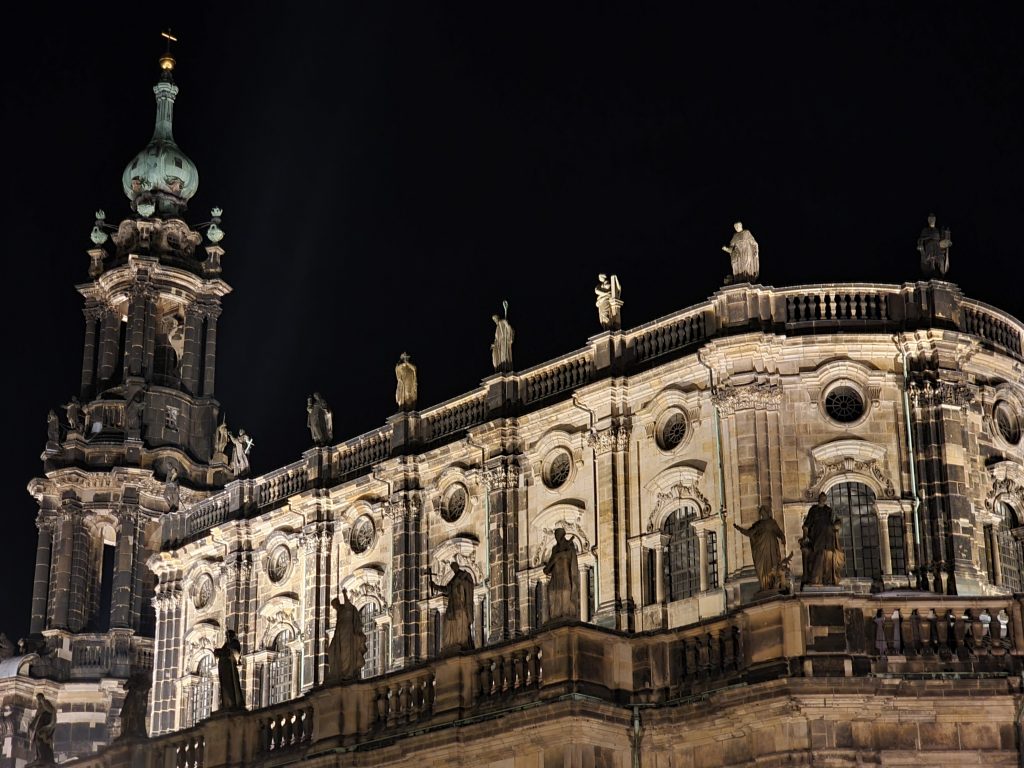

There is nothing I enjoy more than traveling alone. Just walking without a map and deciding where to go based on a feeling. Dresden’s city center is old and rather compact, full of architecture, which had to be rebuilt after WWII. I see an old building here, I see an old building there, I chill at the fountain next to another old building and take some pictures for my parents. A busker is playing on an empty square, at eleven in the evening. I spot the riverside and while I’m walking closer, I see a sign saying “Semperoper”. Hold up, I know that one. I look where the arrow is pointing and realize, I just sat next to the Opera building built by Gottfried Semper, without even noticing. I made a project on this building once and remember the weird feeling of being unreasonably proud when the professor complimented my work, even though the class of Architecture history was certainly not even a bit interesting to me. After walking around I again become a victim of the lack of public toilets and need to head back to the hotel. Content with the German Weizen experience, having seen some cool places, I wrap it up and the day concludes on a joyful note.
The next day, I feel super fancy eating hotel breakfast (I am from the cottaget-in-the-woods-vacation kind of family), then we board the bus and after buying a nasty Mcdonald’s café macchiato, we soon arrive in Dessau. I strategically packed a tote bag that I bought when attending a summer school at Bauhaus Universität in Weimar, that is supposed to make me look like I know something about Bauhaus. First stop is Umweltbundesamt in Dessau, which is so crazy sustainably cool it makes me feel like I’m in a movie. It is one of great examples that show, what makes a building sustainable. The color of the facade corresponds with the surroundings (green around the park area, red around the street) and the whole building is essentially a greenhouse with its own semi-private space. Germans apparently have a thing for having windows facing an interior atrium. Windows are equipped with special blinds, which allow the light to come in in the upper part of the window, while blocking the heat. Most of the consumed energy comes from solar panel collectors on the roof of the building and geothermal heat collectors. There is a building in the courtyard, which uses literal solar panels as facade cladding. We climb a lot of stairs, apparently the individual departments are organized vertically, since the strip of office spaces just would be too long to walk. As I start to question the accessibility, the tactile markings used for the orientation of visually impaired visitors on the floor become.. not tactile, and the reason behind that remains a mystery to me until this day.
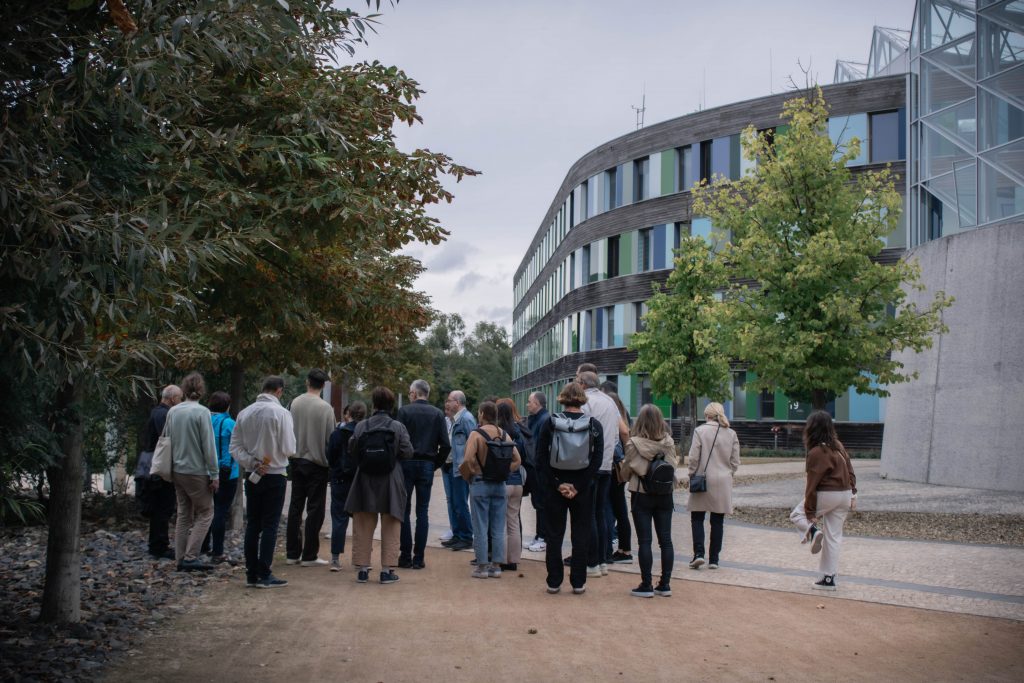
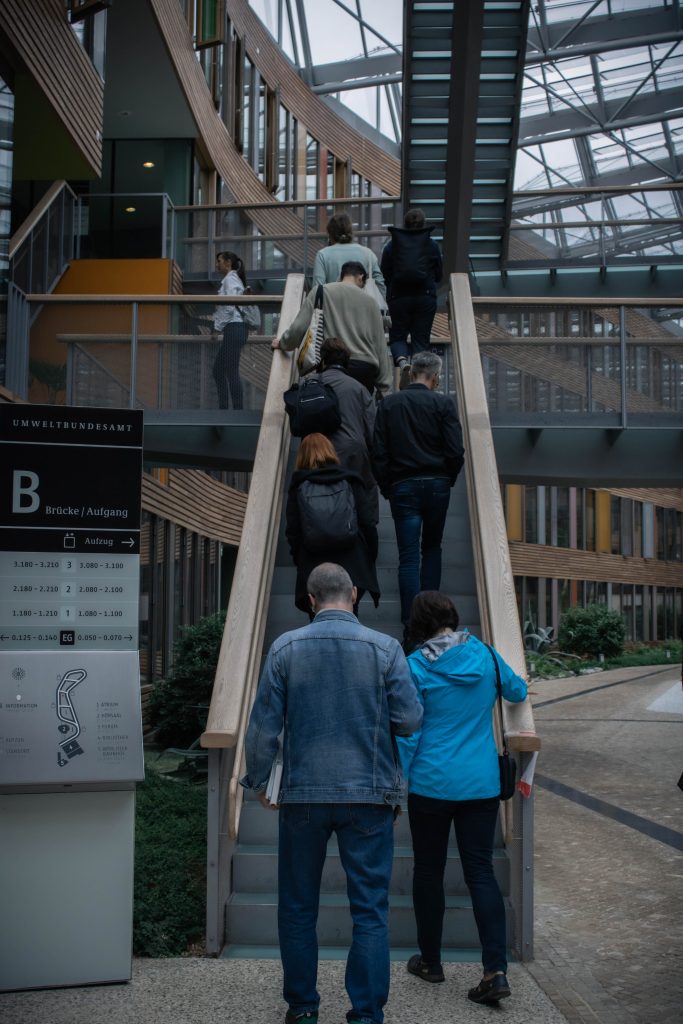
After the excursion, I again separate from the group and instead of a time-consuming lunch I grab some german fast food, eat in in three bites, again tell some random people that I in fact “nicht so gut deutsch spreche” and start a fight with my google maps app. The conflict escalates when I realize that after trying to get to the city center (consisting of one street) for quite some time and my sense of direction totally failing me, it’s already time to again meet the group and visit the Bauhaus building. Our guide is so enthusiastic about what he’s saying, it makes us laugh a bit in the beginning, but we all soon match the vibe and passionately admire the Gropius’ lamps and stools. Standing on the balcony of the Bauhaus building and having the characteristic tubular railing only reach up to my hips, I achieve a new level of completeness.
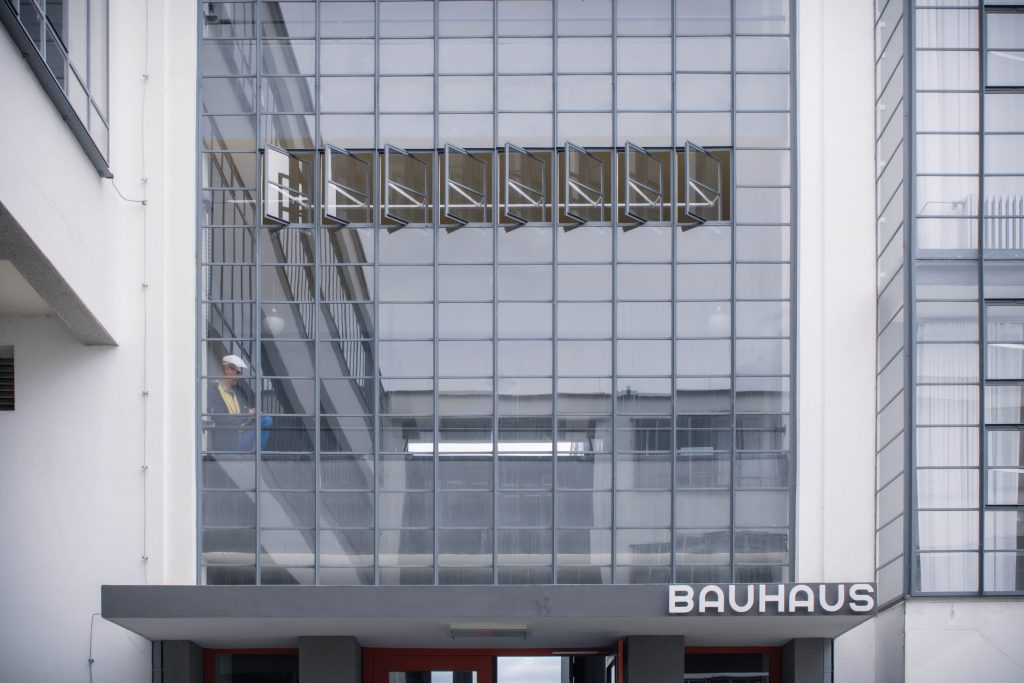
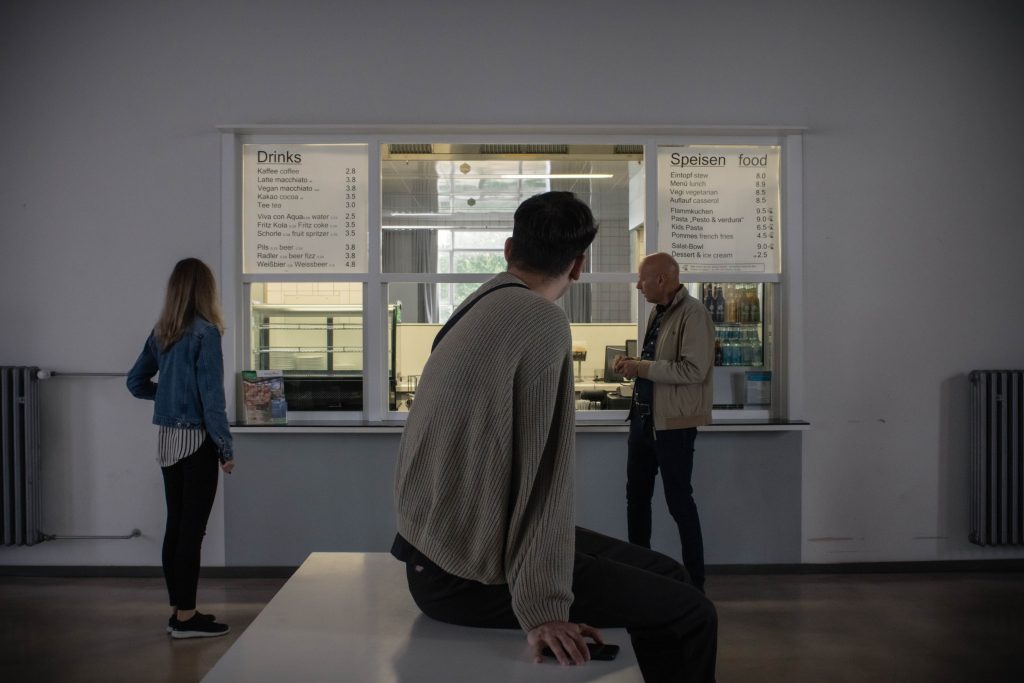
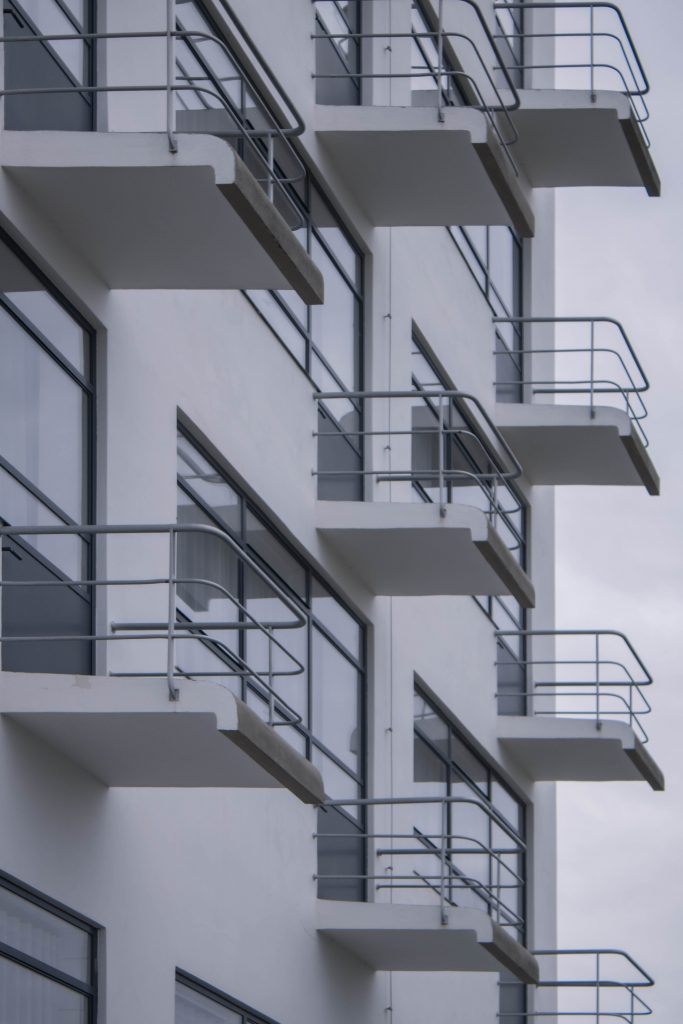
The way the building was designed revolutionized the way we form architecture mass, creating the light space just as a way of bordering the interior. Glass facade can be considered as regressive in terms of the building climate, but this experiment was a necessity in order to form the path towards nowadays widely used insulating glass forms. All my energy is drained as we walk towards the Meisterhäuser, a few of us raid the coffeeshop and hope to be able to boost the ability to focus for the last parts of the day. After visiting the villas built for the masters at the school and seeing some questionable floor plan choices, we again board the bus. I thank genetics for having short legs as I lay down on the seats and dream about Berlin.


We arrive in Berlin quite late and we agree to meet in a few minutes to get to the city center by our own bus, since although we live in the city, it is anyway an hour-long drive to the center, which my small-country mind can’t even comprehend. Although I had come to terms with the fact that I might be spending the friday night in Berlin alone, we in the end split (based on age) into groups organized by the price we are willing to spend on the night out. We settle with just being outside, experience the Berlin air, dynamic public space, some kebabs and let Berlin experience us. Having only a few hours before having to board the bus again, we didn’t even try to get into a club. But try explaining that to the people who have to wait for you in the morning, after you forgot to set an alarm, and a call stating that everyone is waiting for you in the bus wakes you up. Intimidating.
Our morning starts with a visit to the New Galerie by David Chipperfield architects, a sustainable architecture firm. This building was carefully reconstructed after WWII bombings and did not try to fully copy what stood there before, but restore parts of the museum while inserting new elements. James-Simon Galerie, a recently opened new museum, was our next stop. I also did a project about this one. The building is not trying to blend in, but rather connect existing museum buildings and reference different elements used around the museum island. It is a great example of physical accessibility, with solutions such as wheelchair friendly cloakroom counter, tactile signage directly on the stair railing, multisensory orientation plans etc. Last Berlin piece was the New national gallery by Mies Van der Rohe, which was refurbished just three years ago, again by David Chipperfield architects. This building is essentially a table, the outer structure provides stability, while the glass curtain walls’ purpose is to border the inner open space.
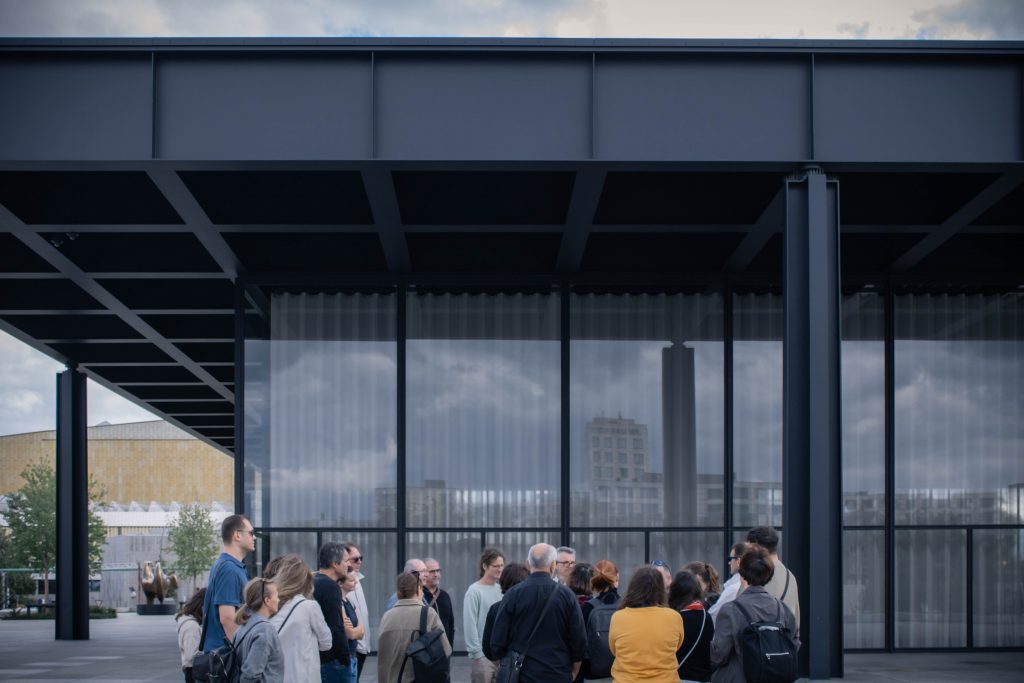

After finishing Berlin excursions, we hop on a bus and get ready for a ride home. It’s become a routine already, to be woken up at the exact moment I’m drifting off, to stop at a gas station. Feels weird, the longer the bus rides are, the shorter they feel. Of course I didn’t open my book, nor do any work on my phone once during the three days. Well okay, I did post some instagram stories, which took longer than expected, and removed some pics from the camera, but that’s about it. It indeed is beautiful to be so care-free for a bit, to just look out of the window and visit some of the most important sites in the world of architecture.
Last spontaneous stop is Uhelný mlýn in Czechia, which we have the opportunity to see with a commentary directly from the architect. Although it was a complicated and bureaucratic process, Patrik Hoffman renovated an old industrial coal mill brownfield into a multi-purpose space, where culture and art is welcome. Some spaces, such as underground cellars, were transformed to be accessible again, and the whole complex is a mixture of respectful preservation and modern renovation processes.
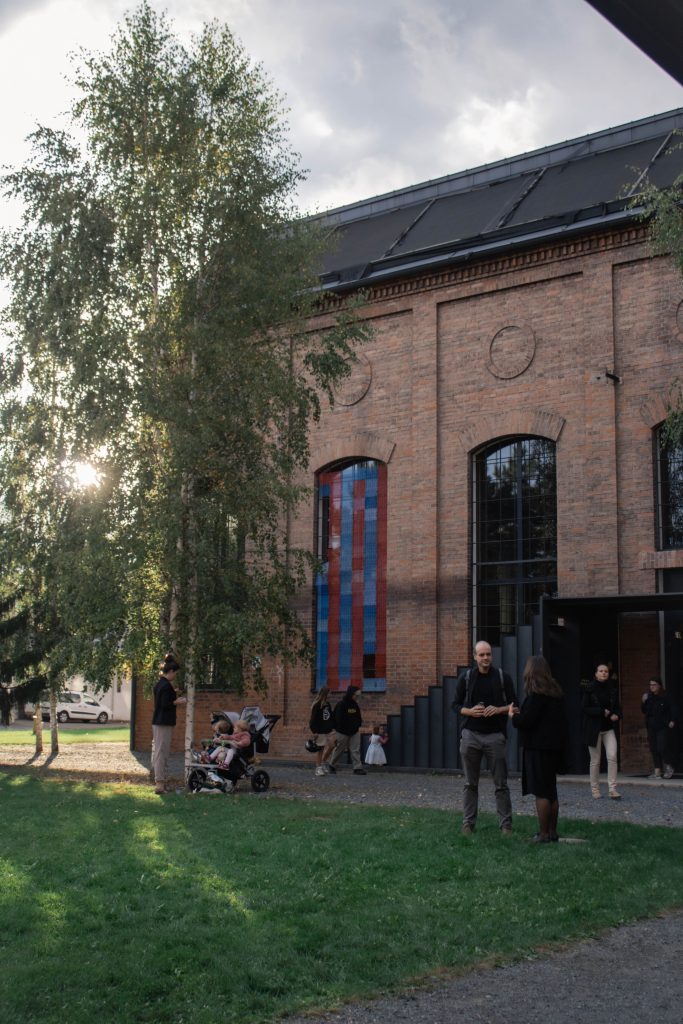
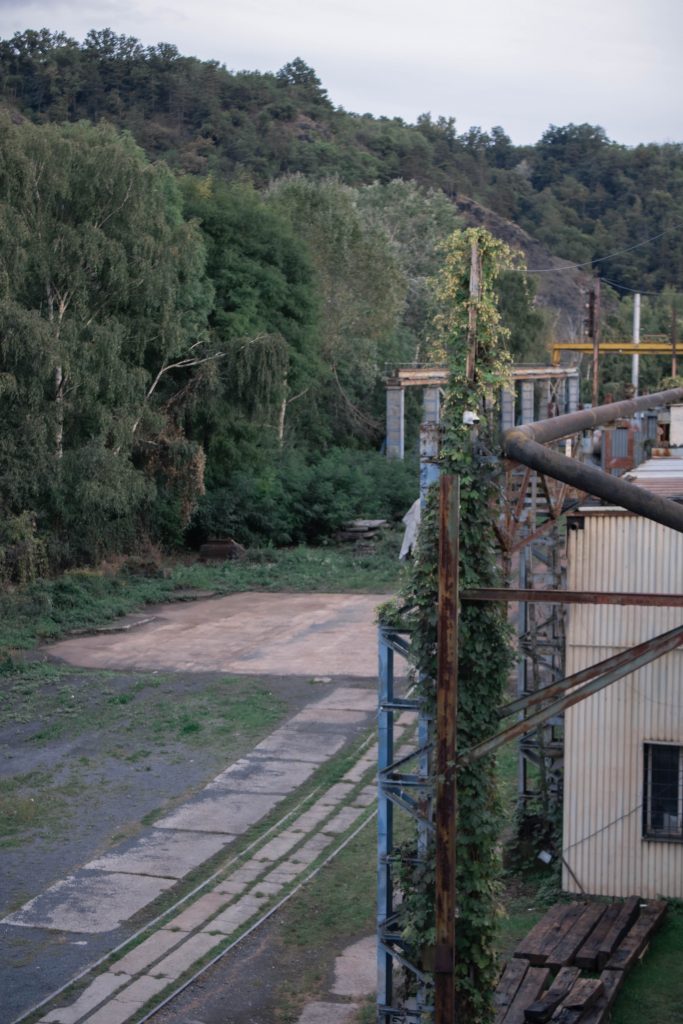
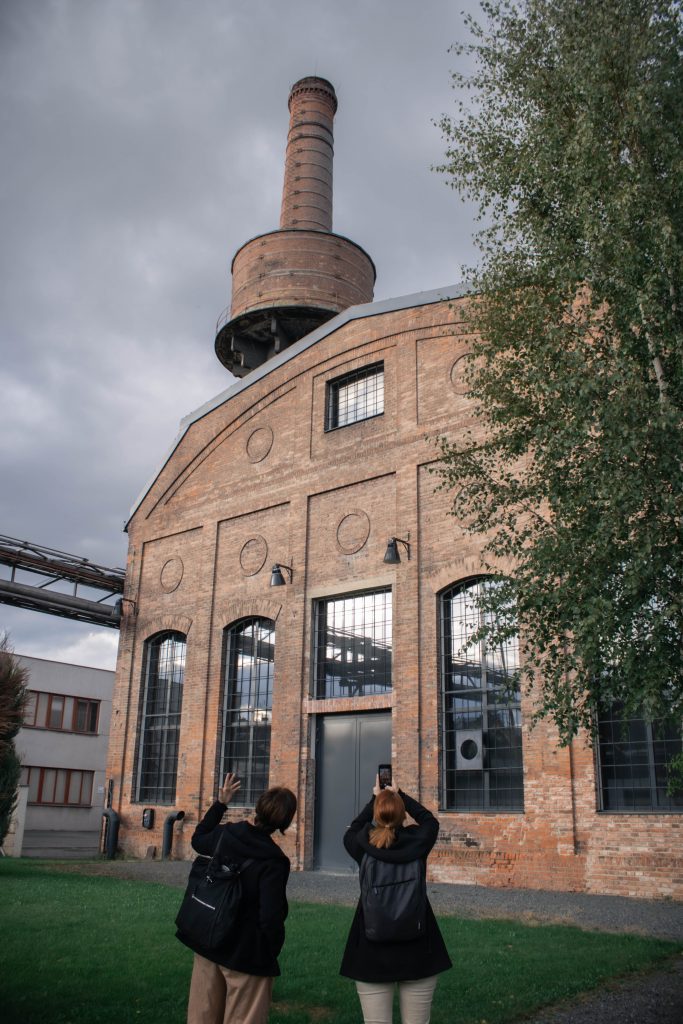
The rest of the ride we spend with a so-called podcast – a series of very informal conversations within the bus. A bunch of different people joined this trip, from top Slovak architects, construction firm owners, bankers, to students. Everyone has something to say, regarding the trip, the world of architecture, New European Bauhaus, life in general. The bus is driving through the dark landscape, people are closing their eyes but listening carefully. There’s silence, we don’t have a dialogue but we feel involved in the monologues happening in the front of the bus, playing through the speakers above our heads. There’s a weird feeling, it’s hard to explain, it’s like when you have to go home from a trip and feel sad, but also somehow satisfied at the same time. The lights are dim. You feel like you know the people you present the last three days with, on a weird level. You want to use the last chance to share, to maybe influence something, talk about your personal experience and think about the future, how to care about sustainability and reevaluate what you learned from the trip.

I had a chance to speak. Prepared the first few sentences in my head, the rest was a mess but hey, I still have some more years to learn how to talk concisely and precisely in public. Tried to emphasize the importance of informal education – I, myself, am privileged enough to have been able to attend several summer schools, workshops and conferences and there I learned an incredible amount of information, gained so much experience and made important networking decisions. Informal education allows people to take their own approaches and extract the knowledge an individual might be lacking. I don’t want to generalize the situation, so I’m speaking about my home country, but young people are leaving in masses and we need to learn how to motivate them, hear them out, give them an opportunity. Employing students, paying them (!) and cultivating the talent is necessary to grow the society as a whole.
Sustainability needs to be implemented into different fields and not only big projects – which however still are a way of leading the way and setting an example. We at build_shift promote different ways of spreading the knowledge and expertise in order to widen the pool of sustainability experts, that way a fair approach is not only a thing of fancy big sustainable projects in western Europe but becomes a standard. Both formal and informal education as well as practical experience can allow stakeholders in the field of built environment to produce more fair and responsible results.
So, what did I learn? Probably something very different than the people that actually understand architecture. Isn’t that the point, though?

Photo credits: Slávka Fratričová
Images are copyrighted and may not be used, reproduced, or distributed without the photographer’s permission.
This study tour was organized by a Slovak sustainable housing organization iEPD (Passive House Institute Slovakia). It is a part of the initiative Manifest 2020, which is the first Slovak partner of the New European Bauhaus. The aim of this project is to support sustainability, cultural development and investment in order to fulfill the goals of the European Green Deal. Excursion discovers inspiring examples of architecture renovation and urban transformation, in order to give professionals and nonprofessionals a valuable insight into the values of the New European Bauhaus. Topics explored were sustainability, innovation, heritage, renewable resources, inclusion and accessibility. All excursions and tours were held in english.
Study tour webpage (in slovak): https://iepd.sk/study-tour-new-european-bauhaus/

